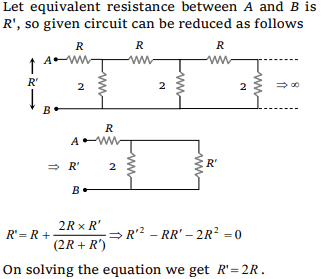1.In the figure, current through the 3 Ω resistor is
0.8 ampere, then potential drop through 4 Ω
resistor is

a) 9.6 V
b) 2.6 V
c) 4.8 V
d) 1.2 V
Explanation:

2.Three resistances 4 Ω each of are connected in
the form of an equilateral triangle. The effective
resistance between two corners is
a) 8 Ω
b) 12 Ω
c) \[\frac{3}{8}\] Ω
d) \[\frac{8}{3}\] Ω
Explanation:

3. What will be the equivalent resistance between
the two points A and D
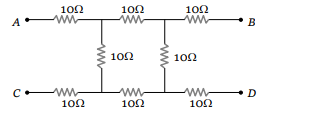
a) 10 Ω
b) 20 Ω
c) 30 Ω
d) 40 Ω
Explanation: Resistances at C and B are not in the circuit. Use laws of resistances in series and parallel excluding the two resistance.
4. What is the equivalent resistance between A and B
in the figure below if R=3 Ω

a) 9 Ω
b) 12 Ω
c) 15 Ω
d) None of these
Explanation: After simplifying the network, equivalent resistance obtained between A and B is 8 Ω
5. What is the equivalent resistance between A and B

a) \[\frac{2}{3}R\]
b) \[\frac{3}{2}R\]
c) \[\frac{R}{2}\]
d) 2R
Explanation: The circuit consists of three resistances (2R, 2R and R) connected in parallel
6.The current in the following circuit is

a) \[\frac{1}{8}A\]
b) \[\frac{2}{9}A\]
c) \[\frac{2}{3}A\]
d) 1A
Explanation:

7. What is the equivalent resistance of the circuit

a) 6 Ω
b) 7 Ω
c) 8 Ω
d) 9 Ω
Explanation:

8. The equivalent resistance of the circuit shown in
the figure is
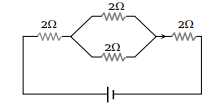
a) 8 Ω
b) 6 Ω
c) 5 Ω
d) 4 Ω
Explanation:

9. In the given figure, the equivalent resistance
between the points A and B is
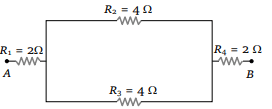
a) 8 Ω
b) 6 Ω
c) 4 Ω
d) 2 Ω
Explanation:

10. An infinite ladder network is arranged with
resistances R and 2 R as shown. The effective
resistance between terminals A and B is
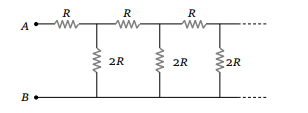
a) \[\infty\]
b) R
c) 2 R
d) 3 R
Explanation:
